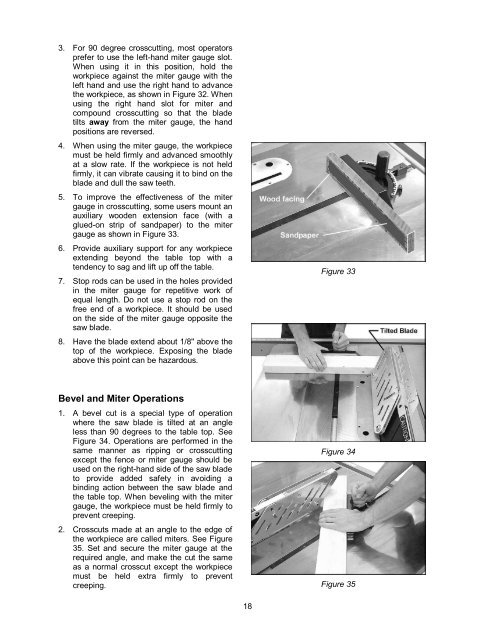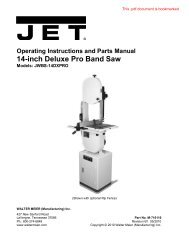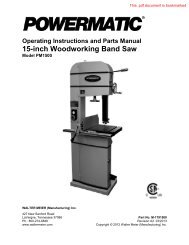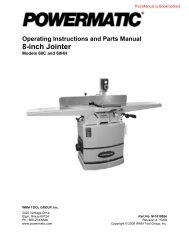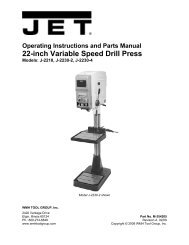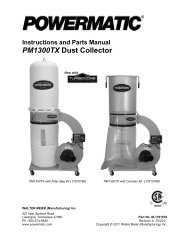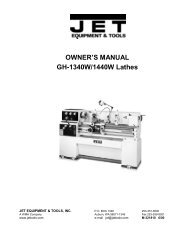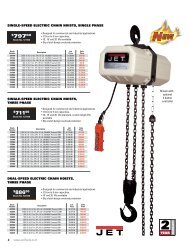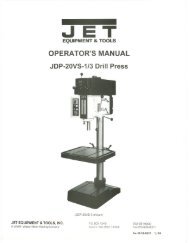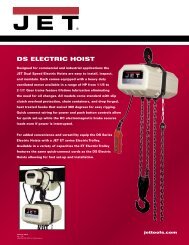Powermatic Model 66 Table Saw Manual.pdf - Woodworkers Guild
Powermatic Model 66 Table Saw Manual.pdf - Woodworkers Guild
Powermatic Model 66 Table Saw Manual.pdf - Woodworkers Guild
Create successful ePaper yourself
Turn your PDF publications into a flip-book with our unique Google optimized e-Paper software.
3. For 90 degree crosscutting, most operators<br />
prefer to use the left-hand miter gauge slot.<br />
When using it in this position, hold the<br />
workpiece against the miter gauge with the<br />
left hand and use the right hand to advance<br />
the workpiece, as shown in Figure 32. When<br />
using the right hand slot for miter and<br />
compound crosscutting so that the blade<br />
tilts away from the miter gauge, the hand<br />
positions are reversed.<br />
4. When using the miter gauge, the workpiece<br />
must be held firmly and advanced smoothly<br />
at a slow rate. If the workpiece is not held<br />
firmly, it can vibrate causing it to bind on the<br />
blade and dull the saw teeth.<br />
5. To improve the effectiveness of the miter<br />
gauge in crosscutting, some users mount an<br />
auxiliary wooden extension face (with a<br />
glued-on strip of sandpaper) to the miter<br />
gauge as shown in Figure 33.<br />
6. Provide auxiliary support for any workpiece<br />
extending beyond the table top with a<br />
tendency to sag and lift up off the table.<br />
7. Stop rods can be used in the holes provided<br />
in the miter gauge for repetitive work of<br />
equal length. Do not use a stop rod on the<br />
free end of a workpiece. It should be used<br />
on the side of the miter gauge opposite the<br />
saw blade.<br />
8. Have the blade extend about 1/8" above the<br />
top of the workpiece. Exposing the blade<br />
above this point can be hazardous.<br />
Bevel and Miter Operations<br />
1. A bevel cut is a special type of operation<br />
where the saw blade is tilted at an angle<br />
less than 90 degrees to the table top. See<br />
Figure 34. Operations are performed in the<br />
same manner as ripping or crosscutting<br />
except the fence or miter gauge should be<br />
used on the right-hand side of the saw blade<br />
to provide added safety in avoiding a<br />
binding action between the saw blade and<br />
the table top. When beveling with the miter<br />
gauge, the workpiece must be held firmly to<br />
prevent creeping.<br />
2. Crosscuts made at an angle to the edge of<br />
the workpiece are called miters. See Figure<br />
35. Set and secure the miter gauge at the<br />
required angle, and make the cut the same<br />
as a normal crosscut except the workpiece<br />
must be held extra firmly to prevent<br />
creeping.<br />
18<br />
Figure 33<br />
Figure 34<br />
Figure 35


